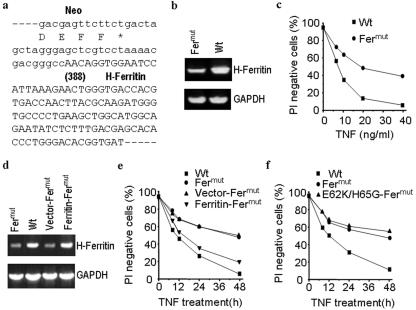FIG. 1.
H-ferritin mutation leads to a resistance to TNF-induced cell death in L929 cells. (a) The fused mRNA of neo and an endogenous gene in a TNF-resistant L929 clonal cell line was amplified by 3′ RACE. The junction sequence of the fused cDNA is shown, which reveals that the viral insertion occurred at the coding region of the H-ferritin gene. Amino acid sequence at the C terminus of neo is shown beneath the cDNA sequence. The sequence introduced by the viral vector is shown in lowercase. The number in parentheses indicates the position relative to the start codon of ferritin. (b) H-ferritin mRNA is reduced in H-ferritin mutant cells (Fermut). A semiquantitative RT-PCR was performed using the total RNA from wild-type parental (Wt) and Fermut cells, and an ethidium bromide stain is shown. (c) Wild-type and Fermut cells were treated with different concentrations of TNF as indicated. The cells were harvested 48 h after the treatment, and cell viability was assessed by PI exclusion. (d) Stable cell lines were generated from Fermut cells by transfection of H-ferritin expression vector (Ferritin-Fermut) or empty vector (Vector-Fermut). The H-ferritin mRNA levels were examined by semiquantitative PCR. GADPH, glyceraldehyde-3-phosphate dehydrogenase. (e) The cells described for panel d were treated with TNF (40 ng/ml) for different periods of time. Cell viability was assessed by PI exclusion. (f) Stable cell lines were generated from Fermut cells by transfection of an expression vector for an H-ferritin mutant with an inactive ferroxidase center (E62K/H65G-Fermut). The sensitivity to TNF-induced cell death was measured as described for panel e.

